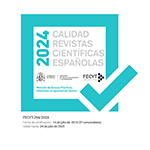El dialecto: estigma y obstáculo en la recepción del Wiener Volkstheater
Abstract
El gran reconocimiento del que goza el teatro popular vienés en Austria, especialmente las obras de Johann Nestroy y Ferdinand Raimund, contrasta con una apreciación mucho menos favorable en la vecina Alemania, sobre todo si se comparan las historias de la literatura escritas a ambos lados de la frontera. Una de las razones que ha contribuido a limitar la recepción de esta literatura es el empleo del dialecto local. Éste se introduce como recurso lingüístico que crea, en el seno del texto, contrastes respecto de la lengua estándar. El uso del dialecto ha llevado a que el teatro popular vienés a menudo haya sido clasificado, erróneamente, como literatura dialectal. El análisis pormenorizado de la realización lingüística del lenguaje popular, presente en las obras, demuestra que se trata de textos dialectalmente marcados. La presencia de rasgos dialectales ni impide la comprensibilidad suprarregional de estos textos ni justifica el confinamiento local de una literatura cuyo valor estético justificaría su inclusión en el canon de la literatura universal.Downloads
##submission.format##
Licenza
La Revista de Filología Alemana, para fomentar el intercambio global del conocimiento, facilita el acceso sin restricciones a sus contenidos desde el momento de su publicación en la presente edición electrónica, y por eso es una revista de acceso abierto. Los originales publicados en esta revista son propiedad de la Universidad Complutense de Madrid y es obligatorio citar su procedencia en cualquier reproducción total o parcial. Todos los contenidos se distribuyen bajo una licencia de uso y distribución Creative Commons Reconocimiento 4.0 (CC BY 4.0). Esta circunstancia ha de hacerse constar expresamente de esta forma cuando sea necesario. Puede consultar la versión informativa y el texto legal de la licencia.










